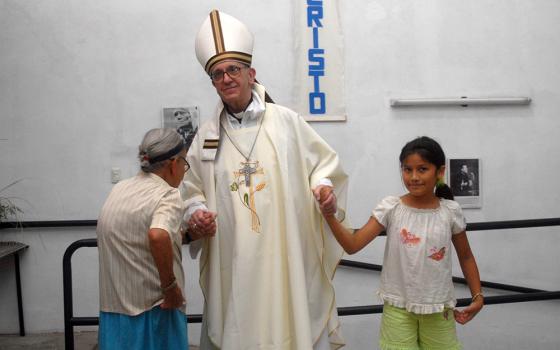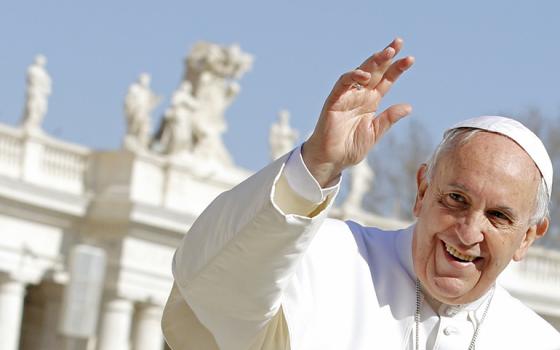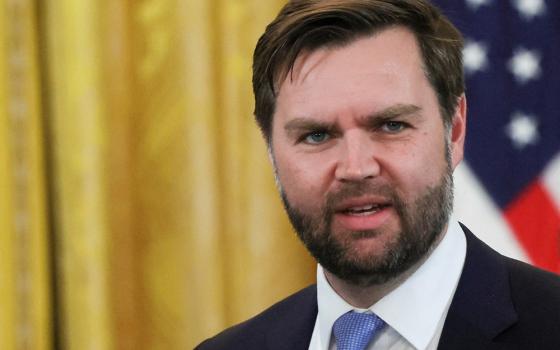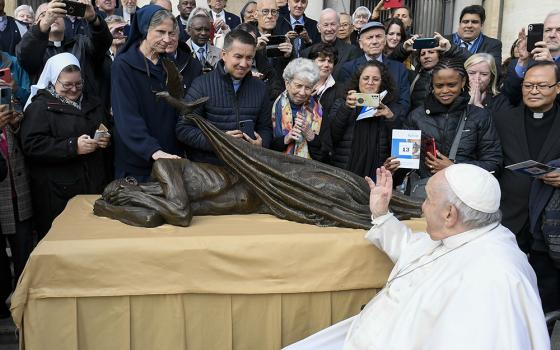A child's red dress hangs on a cross near the grounds of the former Kamloops Indian Residential School June 6, 2021. The remains of 215 children, some as young as three years old, were found at the site in May in Kamloops, British Columbia. Pope Francis expressed his sorrow at the discovery of the remains at the school, which was run from 1890-1969 by the Missionary Oblates of Mary Immaculate. (CNS/Reuters/Jennifer Gauthier)
The Catholic Church enjoyed a bit of a renewed honeymoon with the global media after the May 21st announcement of the "synodal process 2021–2023." But the love fest lasted only about a week.
It was brought to an abrupt and ugly end when law enforcement officials in Canada discovered 215 unmarked graves of indigenous children at a former Catholic-run residential school in British Columbia.
International organizations quickly demanded that the Church in Canada and the Holy See admit responsibility for the tragedy.
Pope Francis expressed his "closeness with Canadians traumatized by the shocking news," as he addressed pilgrims in St. Peter's Square at last Sunday's Angelus. But he stopped short of issuing a direct apology.
June 4th, that fateful day
Canada's Catholic Prime Minister, Justin Trudeau, insisted that the Church and the Holy See must take responsibility for what happened at the school.
In a video statement on June 4 he even alluded to the possibility that Church officials could be taken to court.
That just happened to be the very same day that German Cardinal Reinhard Marx made the shocking announcement that he had asked the pope several days earlier to accept his resignation as archbishop of Munich and Freising.
Marx is one of Francis' closest allies and, at age 67, he's still several years shy of the normal retirement age of 75.
He said the reason for his resignation was to take responsibility for the "systemic failure" of the Catholic Church in dealing with the sex abuse crisis.
The cardinal's letter was a signal to some of his fellow bishops in Germany. But it was also a message to the Vatican and the pope that there is great frustration with the slow pace of Church reform.
Advertisement
Repenting of past sins
These last two weeks demonstrate the predicament of the Catholic Church today. Every time the ecclesiastical hierarchy has tried to turn a new page, the past has come back to bite them.
In some sense, it's the story of post-Vatican II Catholicism.
First, in the period between the Second Vatican Council (1962-65) and the early years of John Paul II's pontificate in the 1980s, the Church apologized for anti-Semitism.
And, yet there are things that the Vatican still cannot afford to say to the State of Israel about its treatment of Palestinians, as we witnessed in the most recent chapter (last month) of the Israeli-Palestinian conflict.
Then, in the 1990s, John Paul II prepared to usher in the new millennium and the Great Jubilee of 2000, by issuing a series of apologies for sins that "members of the Catholic Church" had committed over the centuries.
These included sins against the Jews, against peace, the rights of peoples, respect for cultures and religions, the dignity of women, the unity of humankind, the fundamental rights of the person and so forth.
And yet, the late Polish pope had a fundamental blindness towards the sex abuse scandal in the Catholic Church.
A new stage: meeting victims
The Great Jubilee of 2000 was supposed to open a new page in the long saga of the Church's desired reconciliation with the world. Instead, the beginning of the new millennium unfolded under a dark cloud — revelations of sexual abuse in Boston.
Some cardinals believed the list of Church sins John Paul compiled for the "purification of memory" was way too long. In hindsight we can see it ended up being way too short.
Benedict XVI then began the practice of meeting victims of sexual abuse during papal trips abroad. He did this on his visits to Australia, the United States, Malta and Germany.
And he even met with a group of First Nations people from Canada who visited the Vatican.
And yet, Benedict's reading of the sex abuse crisis did not lead to a serious disciplining of abusers (see, for example, Fr. Marcial Maciel).
Rather, it was shaped by the idea that the plague of sexual abuse was an infection coming from outside of the Church, one of the diseases of liberal modernity spread within Catholicism for lack of doctrinal diligence.
Then came Pope Francis.
Ecclesia semper reformanda?
Although he remained silent on the issue of abuse during the first year of his pontificate, he accelerated the institutional response to the crisis in 2014. He has been even more determined to do so since 2018 and in February 2019 held an extraordinary summit in the Vatican.
Cardinal Marx played an important role in that crucial meeting, as he has in the overall Vatican strategy to deal with the abuse crisis since 2010.
Yet even Francis' actions always seem to fall short of what is expected of the Church and the papacy in terms of the institutional response to the sex abuse crisis.
And since the crisis exploded in the early 2000s as an issue of "pedophile priests", it has widened to other scandals such as the abuse of women religious and vulnerable people, spiritual abuse in new lay communities, the unmarked graves of children in institutions run by the Church in Ireland and Canada, and so forth...
For the Catholic Church in the 21stcentury, the present is unmanageable, the future continues to slip away, and the hope of a fresh start has become elusive.
It is a Church that continually wants to profess to itself and the world, "Ecclesia semper reformanda" — a Church in constant need of reform.
But, in fact, it is being forced by external pressure to be an "ecclesia semper penitens" — a Church that is constantly repenting.
There is no question that, on some issues, repentance must be the modality of the Catholic Church today. Coming to terms with its dark history is an essential task in moving towards the future.
The problem is that it is not clear what kind of future.
Verbal aesthetics or real structural reforms?
The hope for the change in Catholicism today is called synodality. It aims at a less clerical and more co-responsible way of being Church.
But there is an important difference between synodality in the Church in the past and today.
It would be easier to be a synodal Church in a triumphant self-perception — as was the case of the synodal experiences from the Middle Ages, the post-Tridentine period and, in some sense, even in the immediate post-Vatican II Church — than in the Church of today, where public repentance is constantly perceived as inadequate and insincere.
It is a repentance that has not been able to invite forgiveness and reconciliation – not just from secular governments and militant atheists, but even from faithful, churchgoing and dues-paying Catholics.
This is a major break from just even a few decades ago. The vision of the Second Vatican Council for the future of the Church was much more in the footsteps of the traditional "semper reformanda" than in the "semper penitens" of today.
This is why the situation of the Church today is very different from the times of Vatican II, and the invocation of the "hermeneutic of continuity and reform" is tragically inadequate if continuity gets the better of reform.
The future will continue to be an elusive idea in the Church if the elevation of the existential dimension of the faith becomes just verbal esthetics; and if the pastoral dimension becomes clerical mannerism and thus the instrument for an institutional apologetics, a defense of the status quo, as Italian theologian Marcello Neri has noted in his latest book.
But that very well could happen to the synodal process if it is not open to institutional and theological reforms in response to the abuse crisis.
It is not clear whether courageous reform will get the Church out of its current predicament. But it is certain that, without such reform, the Church hardly stands a chance.
Editor's note: This article originally appeared on La Croix International.







